Cosmonaut Alexei Leonov, Who Was First to Walk in Space, Dies at 85 – Space.com
Soviet-era cosmonaut Alexei Leonov, who in 1965 became the first person to walk in space before co-leading the first joint mission between Russia and the United States, has died at the age of 85.
Leonov died on Friday (Oct. 11) at the Burdenko military hospital in Moscow after a long illness.
“One of the first cosmonauts of the world space era, forever devoted to his country and his work, he inscribed himself in golden letters in the world history of space,” said Roscosmos, Russia’s federal space corporation, in a statement. “With Alexei Arkhipovich a whole era has gone.”
Selected alongside Yuri Gagarin among the first 20 Soviet Air Force pilots to train as cosmonauts in 1960, Leonov flew twice into space, logging a total of 7 days and 32 minutes off the planet.
Related: How Leonov’s Historic First Spacewalk Worked (Infographic)
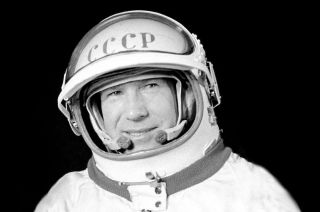
Alexei Leonov, who performed the world’s first spacewalk in 1965 and co-led the first joint mission between the U.S. and Russia, died on Friday, Oct. 11, 2019 in Moscow at age 85.
(Image credit: Roscosmos)
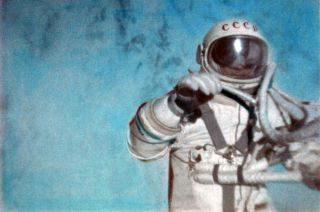
Archived image from the Fédération Aéronautique Internationale report certifying the first spacewalk by Russian cosmonaut Alexei Leonov on March 18, 1965.
(Image credit: FAI)
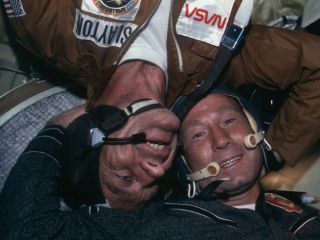
In 1975, Alexei Leonov (right) participated in the Apollo-Soyuz Test Project, which became the first crewed international spaceflight. This image from the flight shows Leonov with NASA astronaut Deke Slayton.
(Image credit: NASA)
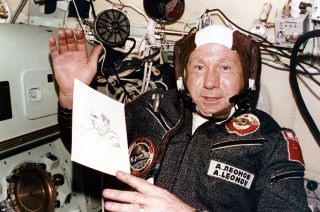
Cosmonaut Alexei Leonov aboard the Apollo-Soyuz Test Project with a sketch he made of one of his American crewmates.
(Image credit: NASA)
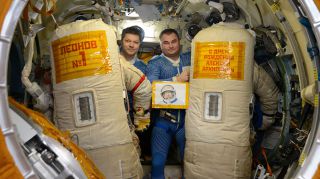
Russian cosmonauts Oleg Kononenko and Alexey Ovchinin honor Alexei Leonov when conducting a spacewalk the day before his 85th birthday.
(Image credit: NASA/Roscosmos)

An in-depth look at the world’s first spacewalk by cosmonaut Alexei Leonov on March 18, 1965.
(Image credit: By Karl Tate, Infographics Artist)
Launched on Voskhod 2, the world’s 17th human spaceflight, on March 18, 1965, Leonov made history as the first person to exit his spacecraft for an extravehicular activity (EVA).
“The Earth is round!” he exclaimed, as he caught his first view of the world. “Stars were to my left, right, above and below me. The light of the sun was very intense and I felt its warmth on the part of my face that was not protected by a filter,” said Leonov in a 2015 interview with the Fédération Aéronautique Internationale (FAI) on the 50th anniversary of his spacewalk.
“What remain etched in my memory was the extraordinary silence,” he said.
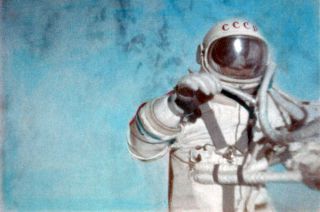
Archived image from the Fédération Aéronautique Internationale (FAI) report certifying that the first spacewalk was conducted by cosmonaut Alexei Leonov on March 18, 1965.
(Image credit: Roscosmos/FAI)
Leonov’s historic EVA, however, almost spelled his end.
After several minutes outside, his spacesuit ballooned, making it very difficult for him to maneuver. His crewmate, Pavel Belayev, unable to do anything to assist, Leonov made the decision to release air from his suit in order to be able to re-enter his capsule.
“I decided to drop the pressure inside the suit … knowing all the while that I would reach the threshold of nitrogen boiling in my blood, but I had no choice,” Leonov told the FAI, the world governing body that certifies aviation and space records.
Ultimately, Leonov made it safely back inside after 12 minutes and 9 seconds floating outside his spacecraft. He and Belyayev returned to Earth the next day on March 19, 1965, having shown it was possible for a human to survive working in the vacuum in space.
In Pictures: The Most Memorable Spacewalks in History
Leonov’s second spaceflight came a decade later with the lift off of the Apollo-Soyuz Test Project (ASTP), the first mission conducted jointly between the United States and Russia.
Launched on July 15, 1975, Leonov and his crewmate, Valery Kubasov, docked their Soyuz spacecraft two days later to an Apollo spacecraft carrying astronauts Thomas Stafford, Deke Slayton and Vance Brand.
“The best part of our joint flight was the occasion when we opened the hatch and I saw the face of Tom Stafford,” said Leonov, recalling the ASTP mission on its 35th anniversary in 2010. “I said, ‘Hello Tom! Hello Deke!’ and at this moment we shook hands.”
The two crews spent almost two days together, conducting scientific experiments and taking part in cultural exchanges. The mission served a precursor to the later Shuttle-Mir flights and the establishment of the International Space Station.
Related: Apollo-Soyuz Test Project: 1st U.S.-Russian Spaceflight Pictures
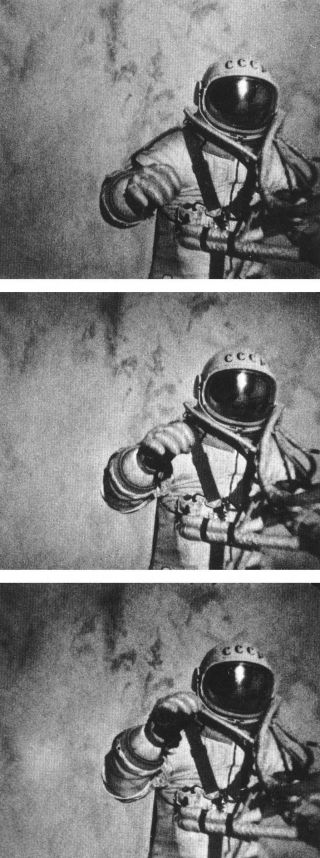
These three stills are from the external movie camera on the Soviet Voskhod 2, which recorded Aleksey Leonov making history’s first spacewalk on March 18, 1965.
(Image credit: NASA/Asif Siddiqi)
After parting ways with the Americans, Leonov and Kubasov landed safely on July 21, 1975. The touch down marked the end of Leonov’s spaceflight career, having completed 113 orbits of Earth on his two missions.
“We were saddened to learn of the passing of Russian cosmonaut Alexei Leonov,” said NASA astronaut Jessica Meir as a spacewalk by two of her crewmates came to its close outside the International Space Station on Friday.
“Though we mourn his passing,” added the station’s commander, Luca Parmitano with the European Space Agency, “it is somewhat fitting that Leonov left us on the day of a spacewalk. His 12-minute excursion outside the Voskhod 2 spacecraft more than a half century ago began a chapter in human spaceflight that brought us to the moon and which will bring the world to distant ports of exploration in the cosmos in the years ahead.”
Alexei Arkhipovich Leonov was born on May 30, 1934, in the town of Listvyanka, near Mariinsk in Siberia. A budding artist from a young age, Leonov enrolled at the Academy of Arts in Riga in 1953 before attending the Chuguyev Air Force School in Kharkov, Ukraine, where he graduated in 1957.
He was serving as a Soviet Air Force parachute instructor when he was selected for the first cosmonaut class three years later. His first assignment was as backup to Valeri Bykovsky on the Vostok 5 mission in 1963.
After returning from his 1965 Voskhod 2 mission, Leonov began training for a mission to the moon. First preparing for a circumlunar flight, a feat accomplished by NASA’s Apollo 8 crew in December 1968, Leonov was one of only three candidates for a Soviet moon landing. Rocket failures though, ultimately led to the program’s cancellation.
Leonov was then assigned to command the second mission to launch to Russia’s first space station, Salyut 1. One of his two Soyuz 11 crewmates however, fell ill days before the June 1971 launch, resulting in their backups flying in their place. (The Soyuz 11 mission later ended in tragedy, when a depressurization during re-entry led to all three cosmonauts being killed.)
Giant Leaps: Biggest Milestones of Human Spaceflight
Following his lead of the Soviet side of the Apollo-Soyuz Test Project, Leonov headed the cosmonaut team until January 1982, when he resigned to become the deputy director of the Gagarin Cosmonaut Training Center in Star City. Ten years later, he left the space program for a management position at Alfa Bank, one of the largest private commercial banks in Russia.
Throughout his career, Leonov continued to pursue his passion for art, flying colored pencils on his spaceflights and becoming the first to sketch in Earth orbit. His subsequent drawings and paintings have been exhibited worldwide, appeared on postage stamps and were published in several collected volumes of his work.
For his service to his nation, Leonov was twice named a Hero of the Soviet Union and awarded the Order of Lenin, among many other honors. A founding member of the Association of Space Explorers, Leonov was inducted into the International Space Hall of Fame at the New Mexico Museum of Space History in 1976 and International Air & Space Hall of Fame at the San Diego Air & Space Museum in 2001.

Cosmonaut Alexei Leonov aboard the Apollo-Soyuz Test Project with a sketch he made of one of his American crewmates.
(Image credit: NASA)
Leonov was further honored as the namesake for a crater on the moon and a spaceship in Arthur C. Clarke’s “2010: Odyssey Two.” In 2017, he was portrayed in the Russian feature film “The Age of Pioneers” (also known as “Spacewalk”) about his Voskhod 2 mission.
In 2004, Leonov co-authored the joint autobiography “Two Sides of the Moon: Our Story of the Cold War Space Race” with Apollo 15 moonwalker David Scott.
Leonov was married to Svetlana Pavlovna Dozenko in 1959, and together they had two children, Viktoria and Oksana (the earlier preceded him in death in 1996).
Follow collectSPACE.com on Facebook and on Twitter at @collectSPACE. Copyright 2019 collectSPACE.com. All rights reserved.
Follow us on Twitter @Spacedotcom and on Facebook.

Need more space? You can get 5 issues of our partner “All About Space” Magazine for $5 for the latest amazing news from the final frontier!
(Image credit: All About Space magazine)






